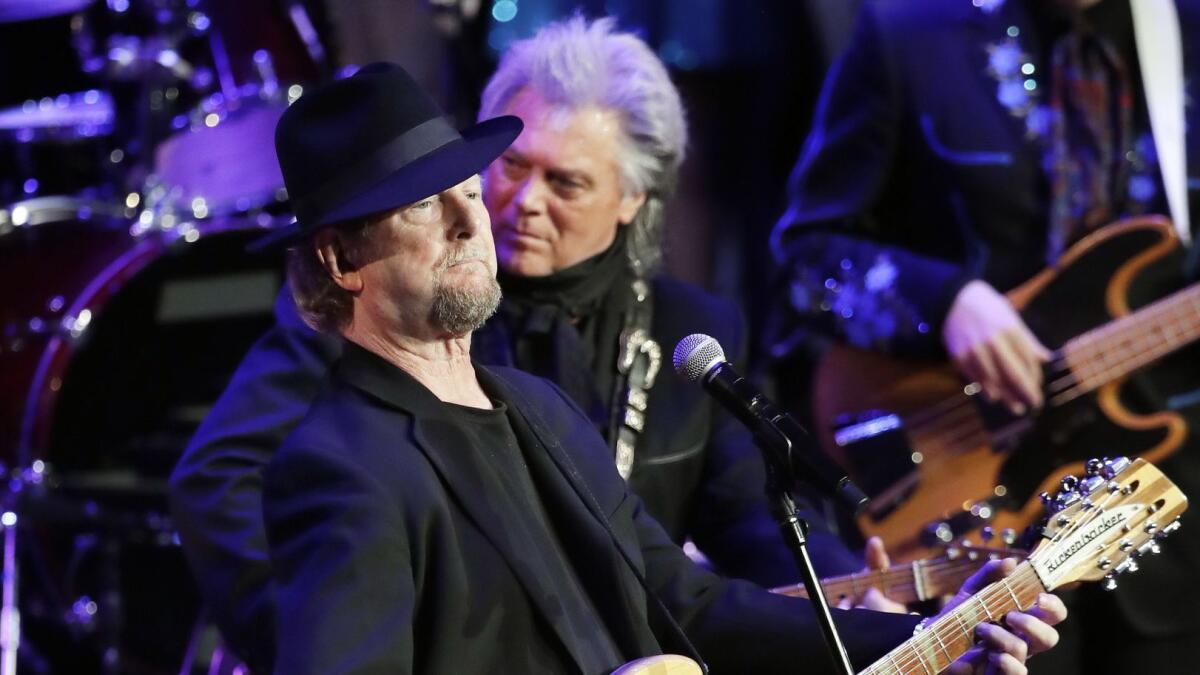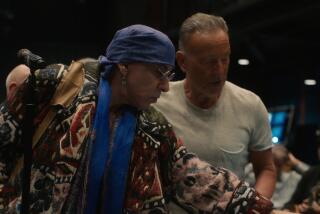Two original Byrds salute the band’s country-rock classic ‘Sweetheart of the Rodeo’ 50 years later

How could a self-respecting rock musician truly rebel in 1968? This, after all, was after the Summer of Love, a time when musical and cultural conventions were regularly being upended.
For two founding members of L.A.’s pioneering folk-rock band the Byrds, the answer was simple: Head south and make a country record. So that’s what they did, with the help of their brash new collaborator, “cosmic cowboy” and country-rock pioneer Gram Parsons.
The album that resulted, “Sweetheart of the Rodeo,” is considered a pivotal moment in the emergence of country-rock.
In its 2012 ranking of the greatest albums ever, Rolling Stone placed “Sweetheart” at No. 120, writing, “The Byrds nailed a bold Nashville classicism, dressing Bob Dylan and Merle Haggard songs in steel guitar and rock ‘n’ roll drive.”
At the time, however, it simply confused rock and country fans.
“When it came out, there was a lot of disappointment along the red-blue divide,” Byrds front man, lead guitarist and songwriter Roger McGuinn, 75, recalled recently. “Rock ‘n’ roll people didn’t like it because it was country, and country people didn’t like it because it was rock ‘n’ roll.”
Today, McGuinn and fellow Byrds founding member Chris Hillman are mounting a 50th anniversary tour saluting the “Sweetheart” album, one that starts July 24 in L.A., the first of two shows at the Theatre at the Ace Hotel downtown. They’ll be supported for these shows by country veteran Marty Stuart and his band, the Fabulous Superlatives, an outfit that always has displayed profound respect for music history and traditions.
A key part of the history of “Sweetheart of the Rodeo” is just how much country traditionalists objected to it. This despite the fact that all the band’s members had deep roots in folk, country and bluegrass before they plugged in and almost single-handedly invented folk rock with their 1965 electrified version of Dylan’s “Mr. Tambourine Man.”
“We took the single to Ralph Emery at [Nashville radio station] WSM — we were so excited about it,” McGuinn said of “You Ain’t Goin’ Nowhere,” another song old pal Dylan had sent their way. “He said, ‘I’m not going to play that on my show — what’s it about?’ ”
McGuinn, noting that Emery stumbled at Dylan’s oblique lyric references to “tailgates and substitutes,” replied, “It’s a Bob Dylan song — I don’t know what it’s about. He’s a poet. But the track is incredibly good, and once people got over the politics of it, they realized that it’s pretty good stuff.”
Further, when the Byrds turned up at the venerated Ryman Auditorium to perform some of their new songs for a Grand Ole Opry radio broadcast, they were heckled and booed, largely for their long hair and Parsons’ spontaneous decision to ditch the Merle Haggard song they were set to play. He substituted his own “Hickory Wind” in its place. Ironically, “Hickory Wind” has since been recorded by dozens of country, rock, folk, bluegrass and Americana artists.
But in 1968, the divide between country and rock was considerable. Never mind that Dylan himself had worked in Nashville two years earlier completing his album “Blonde on Blonde,” and came away singing the praises of the Nashville studio pros who accompanied him and returned the following year to record its successor, “John Wesley Harding.”
None of that, however, figured prominently in the Byrds’ decision to follow him down to Nashville.
“No, not at all,” Hillman, 73, said in a separate interview. “When we were talking about making a country record, or let’s go to Nashville, I’m not sure that [Dylan’s precedent] was brought up immediately. Gram was a big cheerleader for going there, and Gary [Usher, their producer at the time] also was open to that.”
It was a time of turmoil for the Byrds. Toward the end of 1967, McGuinn and Hillman agreed to fire bandmate David Crosby, citing increasing tensions among them. Original singer, guitarist and songwriter Gene Clark had departed early in 1966, while original drummer Michael Clarke jumped ship the following year.
“I know we probably would have figured something out,” Hillman said. “We had just done ‘The Notorious Byrd Brothers’ record, which was a real labor of love and came out better than we anticipated.”
Then Hillman randomly met Gram Parsons while standing in line at a Beverly Hills bank. They quickly discovered a common love of country music, and Hillman invited Parsons to come meet McGuinn at one of the band’s rehearsals.
“I think we were just doing something that caught our interest,” Hillman said. “I don’t think we ever thought in the moment, ‘What will we accomplish with this?’ Gram came into the project with two really good songs — ‘Hickory Wind’ and ‘One Hundred Years From Now,’ both winners. And his youthful exuberance gave us a shot in the arm that we really needed. It was the right thing at the right time.”
Upon arriving in the country music capital, they immediately won over respected Nashville steel guitarist Lloyd Green, whose work is featured prominently on the album.
“Lloyd told me it was the most fun he’d ever had,” Hillman said. “He told me, ‘Normally I’d come in and they’d say, “Play here, or play there.” You guys let me play whatever I wanted.’ We knew he was a good player and we weren’t about to try to tell him exactly what to do.”
Other respected Nashville players who worked on “Sweetheart” included bassist Roy (Junior) Huskey (easily and often confused with his son, also a bassist, Roy Huskey Jr.), banjo player John Hartford and pianist Earl Ball. When the band returned to Los Angeles to finish the album, they also brought in West Coast steel guitarist Jay Dee Maness and guitarist Clarence White, who soon joined the Byrds.
White, in fact, is the two-degrees-of-separation that helps explain Stuart’s role in the 50th anniversary tour.
“Clarence White’s brother, Roland, got me my first job with Lester Flatt’s band,” Stuart said. “For a while, I lived with Roland and his family, and in his house he had a stack of Byrds records. I said, ‘What’s that about?’ and he said, ‘My brother Clarence recorded with the Byrds,’ and that’s how I tuned in to Clarence, and the music of the Byrds.”
Stuart tuned in figuratively and literally. An obsessive collector of historical instruments and other memorabilia, he bought Clarence White’s Fender Telecaster, complete with his B-bender invention that bends a guitar’s B string, which White used on the “Sweetheart” album and other recordings before his death in 1973 at age 29.
“Sweetheart,” Stuart says, has become “part of my DNA” over the years.
“I remember buying ‘Sweetheart of the Rodeo’ in 1973 — it was already in the discount bins,” Stuart said. “I was blown away. It leveled me, because it was the first time I had heard folk and gospel and bluegrass and rock ‘n’ roll and country come together in one place. It was so reflective of my Mississippi upbringing.”
The 50th anniversary tour was McGuinn’s idea — he said he realized earlier this year while traveling with his wife that 2018 represented the album’s half-century mark.
Hillman said he received a call in February from McGuinn, one that came at a good moment after his Ventura home was damaged, but not destroyed, by the devastating Thomas fire last fall.
“There was no better time that now because of the fire,” Hillman said. “We didn’t suffer as much as some, but everything has been so chaotic.” He and his wife had to move out for six months while repairs were being made, and just now are moving back in to half of the house that is livable again.
“It was such a perfect idea,” Hillman said, “I jumped on it right away. I love working with Roger; I miss working with Roger.”
Hillman predicts that “It’ll be a lot better listening to [‘Sweetheart’ material] when we play it on this tour. The songs have seasoned out and we’ll perform them a lot better. There are things on the record that Roger and I both cringe at. My own performances were not up to what I wanted — I was still learning to sing.
“It wasn’t our biggest-selling record,” Hillman said. Indeed, it peaked at No. 77 and spent just 10 weeks on the Billboard 200 Albums chart.
“But critically it probably got the best reaction of all the Byrds albums, and definitely got more praise down the road,” Hillman said. “I’ve said before: It was a good record. It wasn’t my favorite Byrds album, but it was a good, noble experiment. And I think it did open the floodgates in a sense.”
For McGuinn, the project reconnects him not just with a musical peak experience, but also with what he views as a magical place and time in his life.
“I’m very nostalgic about that wonderful time in the early-to-late ’60s,” said McGuinn, a New Yorker who crossed the country after working as a session musician in New York. “I came out to L.A. in 1960 and recorded with the Limelighters at Ash Grove, I played as a kid at Hollywood Bowl. I remember driving around at night in a convertible, smelling the orange blossoms. I loved to hang out at the Troubadour. It was a great time.”
Follow @RandyLewis2 on Twitter.com
For Classic Rock coverage, join us on Facebook
More to Read
The biggest entertainment stories
Get our big stories about Hollywood, film, television, music, arts, culture and more right in your inbox as soon as they publish.
You may occasionally receive promotional content from the Los Angeles Times.










